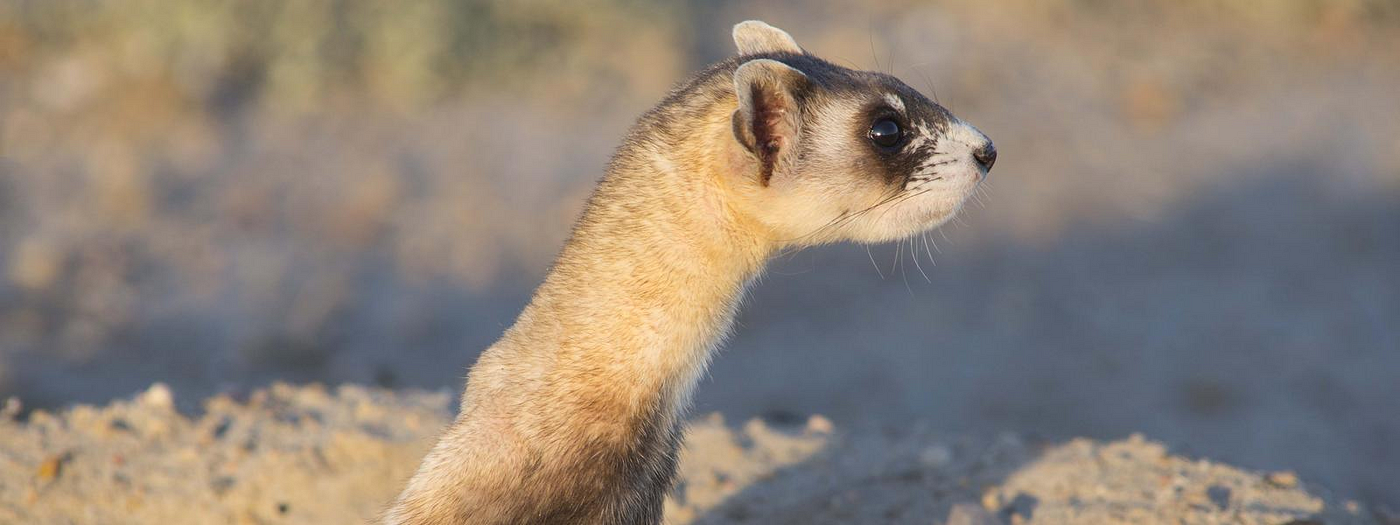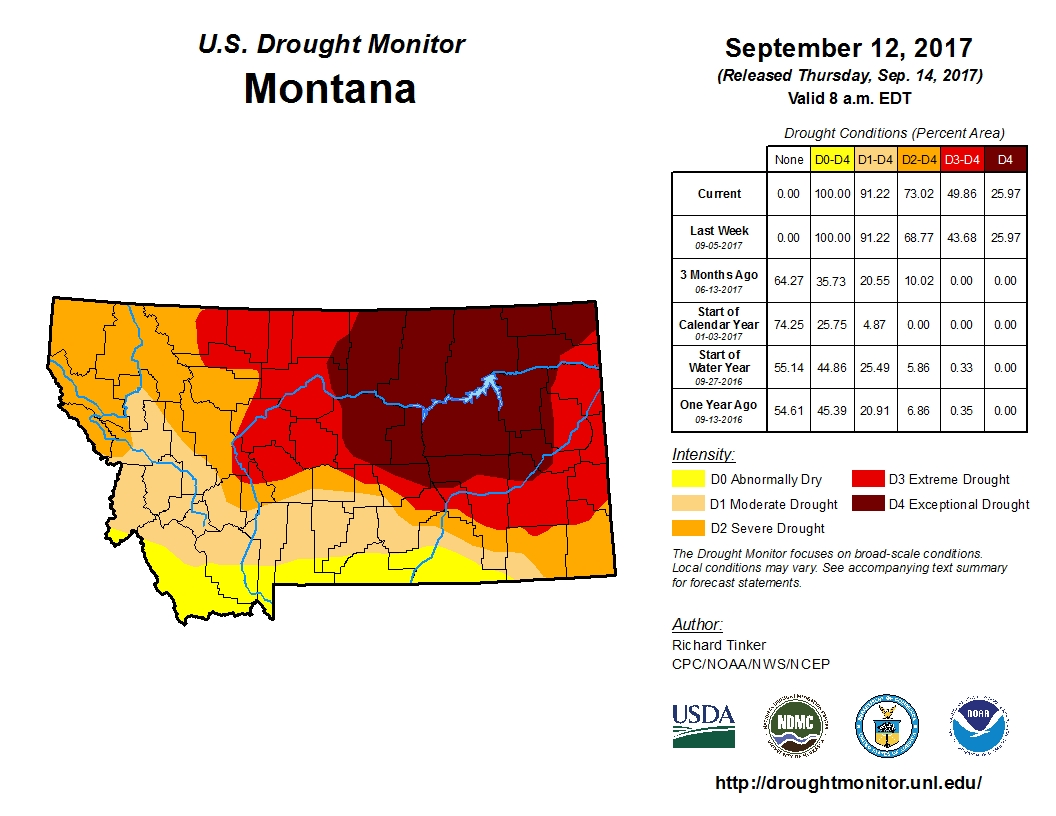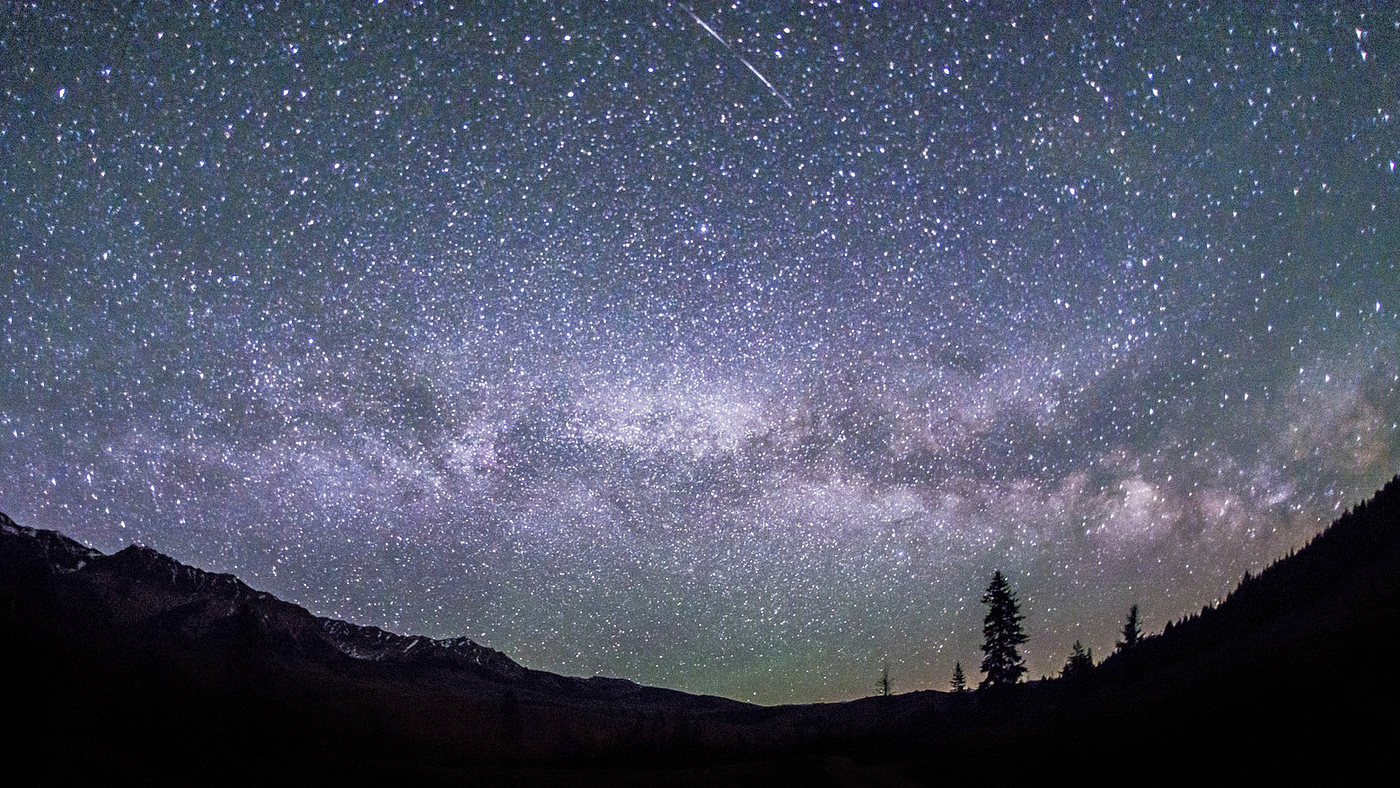Court Spurns Blms irrational Approach to Climate Review
Drones help masked bandits of the prairie
Rockies Today for Friday, September fifteen
Today'south top stories from around the region curated by Mountain West News
How drones and peanut butter are saving rare ferret
In central Montana, drones drop peanut butter pellets on prairie dog colonies, function of an effort by biologists to salve North America's nearly endangered mammal, black-footed ferret, of which only about 300 remain in the wild.

"They are these ferocious, masked-bandits of the prairie," says Kristy Bly, a senior biologist with the World Wildlife Fund. "They're similar these little slinkies."
She says blackness-footed ferrets depend almost entirely on prairie dogs to survive.
"Prairie dogs are Craven McNuggets of the prairie, where and then many species swallow them," she says.
But in contempo years, prairie domestic dog towns across the American West accept been exposed to a deadly illness called sylvatic plague. While it's treatable in humans, sylvatic plague can wipe out entire prairie dog towns in less than a month. And that means no more than food for blackness-footed ferrets.
And then Randy Matchett and Kristy Bly accept spent the summer vaccinating prairie dogs against the plague using drones.
…
The previous evening, every bit the sunday was setting, I was out here with Bly and I asked her why information technology was so of import to salvage black-footed ferrets, especially when it feels similar nowadays, the whole world is in crisis:
"I do think in that location's a lot in the earth that's sad," she says. "And there's a lot that'southward going on in the globe that's out of our control. And when you come to places like this and when you have the opportunity to make a divergence, to bring an endangered species back. Information technology helps restore remainder. It helps to restore missing pieces of the puzzle."
Higher temps + lower precipitation = more fire
As rains begin to fall, the scientists authoring the forthcoming Montana Climate Cess, a report that focuses on climate trends and their consequences for water, forests, and agriculture, sum upward the 2017 wildfire season with something of a "duh."
Climate has played a big role. While it's impossible to tie any 1 conditions event or wildfire directly to climate change, what we can say with certainty is this: increases in temperature in the last decades take set up the stage for drier weather and more fires. In a given twelvemonth, warmer conditions and less precipitation dries out fuel loads and creates conditions for rapid fire spread. Fire records dating back decades to millennia show a clear link between warmer temperatures, lower precipitation and an increment in the number of fires and acres burned. This situation is precisely what nosotros wait to see from climate change.
Montana has been on a steady warming trend for decades, up over 3 degrees Fahrenheit since 1950, and all projections are that it will continue. This summertime was the 2nd warmest on record since 1950 at four degrees Fahrenheit above average, and the persistent high temperatures coupled with the record everyman rainfall in July and Baronial shifted the relatively wet weather condition of spring into extreme drought by mid summer. The speed of the transition from wet to dry was and then rapid that the term "wink drought" has been coined.

And it's expensive…
The Forest Service has spent more than than $2 billion contesting forest fires around the country — a record as wildfires blacken the American West in ane of the nation's worst fire seasons.
Wildfires have ravaged the West this summer with 64 large fires burning across 10 states as of Th, including 21 fires in Montana and xviii in Oregon. In all, 48,607 wildfires take burned nearly 13,000 foursquare miles
Estimate: Wyoming coal-lease climate review 'irrational'
The tenth U.S. Circuit Court of Appeals this morning ruled that the BLM violated the National Environmental Policy Act by skipping in-depth assay of the potential climate impacts from four coal leases in Wyoming's Pulverisation River Basin.
The unanimous conclusion is a major development in NEPA legal precedent. Approximate Mary Beck Briscoe, a Clinton appointee, wrote that BLM'due south approach to weighing greenhouse gas emissions was "irrational."
The conclusion rejects BLM's "perfect substitute" argument, an frequently-cited theory that federal approval of coal leases won't accept an appreciable event on total greenhouse gas emissions because if the government did not greenlight the leases, the same corporeality of coal would exist mined elsewhere.
In its 2010 environmental impact statement for the leases, BLM noted that federal Energy Information Administration projections bespeak an increasing reliance on coal for the nation's free energy needs.
"The BLM then concluded that, because overall demand for coal was predicted to increase, the effect on the supply of coal of the no activeness alternative would have no consequential impact on that need," the stance says. "This long logical leap presumes that either the reduced supply will have no affect on toll, or that any increment in price will not make other forms of energy more attractive and decrease coal's share of the energy mix, even slightly."
Sage grouse. Let's review.
With each news story, the lengthening history of the bird'south conservation in Wyoming is recapped, perhaps losing rich details in the retelling. Hither is a primer of sorts, a collection of fundamental points on the sage bickering timeline, interesting facts or discoveries apropos the grouse and some of the nearly pressing issues in sage bickering management today in Wyoming.
The impossible job that falls to Sarah Coefield
The Missoula-based air quality specialist pens an essay for the Washington Post well-nigh how her job inverse this summer.
My audition is broad and nether stress. As the fires burn, I hear from teachers, parents, coaches, health-care workers and retirees. They call asking where they can become to escape the smoke. They want to know how to protect themselves, what kind of room filters will piece of work, should they article of clothing a mask? They plead for filters I don't have. A child came domicile sick from school — why were the school windows open up? The varsity team is expected to play soccer in the smoke — why hasn't the game been canceled? At that place is smoke inside the Seeley Lake clinic. The nurses are sick. A patient in the dispensary said the smoke makes him want to die. A baby who has been sick in the hospital is beingness discharged, and her family doesn't have money for a filter. An asthmatic grandmother living in Seeley Lake only got custody of her 1-year-quondam grandson, only she's sick from the smoke and worried for the kid. A housebound couple has survived pneumonia three times this yr, and the husband is on oxygen. They are a mile from the fire. Please help, they ask.
And and then I try.
Some requests are easier than others. I track down school athletic directors to brand certain the people arranging soccer games follow the correct guidance. I pull upward a map and figure out how close the cleanest air is. I look at weather patterns and models and make projections about when the fume is likely to clear or worsen. I explain the different wellness categories for smoke. I share information about HEPA room filters and explain how they can help create a condom infinite in a home.
Only the smoke in Seeley Lake thickens on a daily basis. I talk to my supervisors, and we send out an official recommendation that residents leave the surface area until the smoke clears. Few have our advice. Few have anywhere to become.
I telephone call the director of Climate Smart Missoula, which has launched a pilot project to provide HEPA room filters to the elderly, and plead for help. They come through with 25 filters for clinic patients. I call land agencies and ask for money to buy filters and am left empty-handed. We call the Seeley Lake and Lolo simple schools and inquire if they have filtered air for their students. They don't. Nosotros raid our health department budget and purchase 40 HEPA room filters for the schools. Climate Smart Missoula orders 45 more, hoping that someone will stride in to fill the depository financial institution account information technology but emptied. When children's health is at chance, the manager explains, you lot don't expect on details.
I call my contact at the American Lung Association, and she immediately contacts headquarters. They have some money. But I send them to the next canton over, where, for now, the need is greater. I start fielding calls from surrounding counties asking how we found money, how we decided where the filters should become. I send them what information I have.
I start shuffling filters or trying to observe filters on a near-daily basis — five for a clinic, three for a tiny school by the Lolo Peak Fire. There'south an uncomplicated schoolhouse in Condon where 23 students are sitting in fume so thick that visibility has dropped to less than half a mile; we ship them eight. 1 day, I receive three requests for filters I don't have — ii for babies and one for a choking elderly couple. I have their information and hope to try to help. And so I put my head in my hands and weep.
Throughout it all, I send out updates about the smoke: where it's going, how bad it will get, how people can protect themselves. I sprinkle the updates with dumb smoke jokes and asides and dark sense of humour, because information technology's my survival mechanism and maybe it will assist others. People tell me it does.
Just every night, while I prevarication in my bedroom with my filter gently whirring beside me, I know there are vulnerable people sleeping unprotected in the worst smoke we have ever seen.
Idaho hopes to designate beginning night heaven reserve
The get-go International Dark Heaven Reserve in the United States would fill a chunk of Idaho's sparsely populated region that contains night skies so pristine that interstellar grit clouds are visible in the Milky Manner.
"We know the night heaven has inspired people for many thousands of years," said John Barentine, program managing director at the Tucson, Arizona-based International Dark-Sky Clan. "When they are in a infinite where they can see it, it's often a very profound experience."
Supporters say backlog bogus light causes sleeping problems for people and disrupts nocturnal wild fauna and that a dark heaven can solve those issues, boost abode values and draw tourists. Opposition to nighttime sky measures elsewhere in the U.S. have come from the outdoor advertisement industry and those against additional government regulations.
Researchers say 80 percent of North Americans live in areas where light pollution blots out the dark sky. Central Idaho contains 1 of the few places in the contiguous United States large enough and nighttime enough to attain reserve condition, Barentine said. Only 11 such reserves exist in the globe.

More stories we're reading today…
Mountain West News is a regional news service of the O'Connor Center for the Rocky Mountain West at the University of Montana.
Source: https://mountainwestnews.org/drones-help-masked-bandits-of-the-prairie-9123e2b8a516
0 Response to "Court Spurns Blms irrational Approach to Climate Review"
Post a Comment